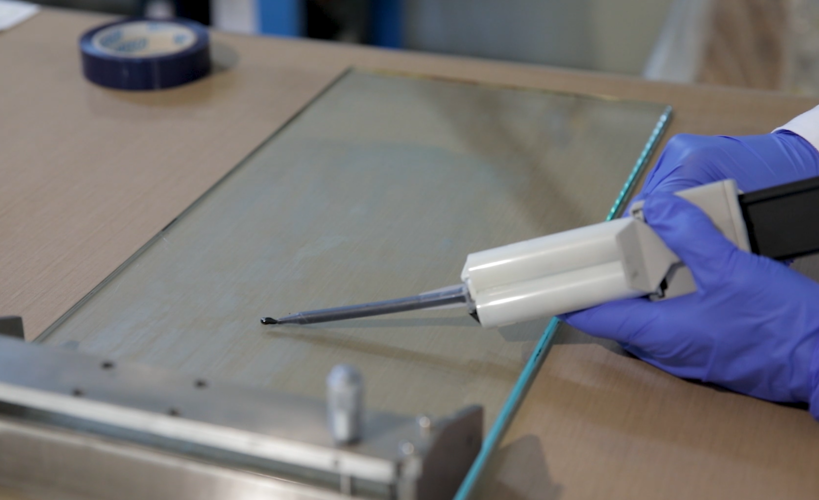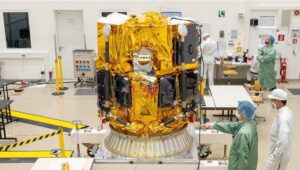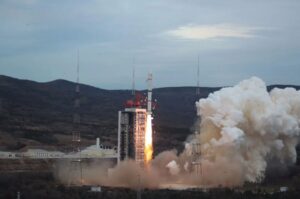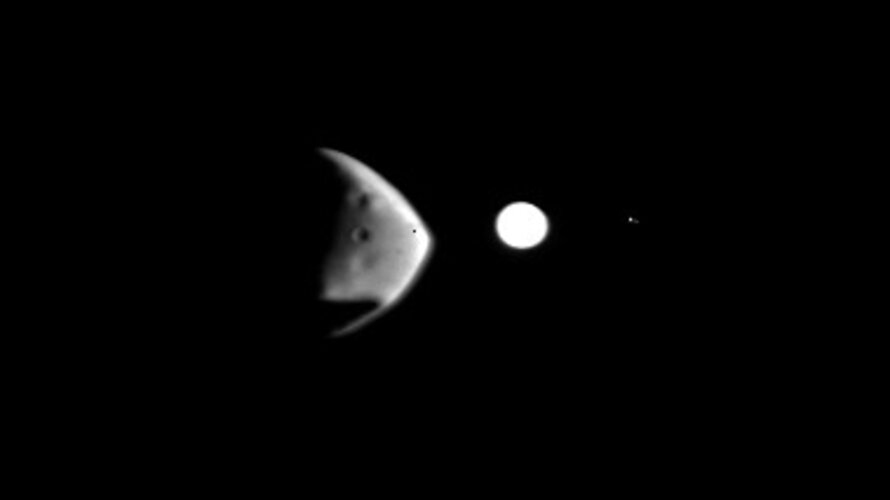Protecting Mars Sample Return spacecraft from micrometeorites requires high-caliber work
Thursday, 13 October 2022 13:08
Micrometeorites are a potential hazard for any space mission, including NASA's Mars Sample Return. The tiny rocks can travel up to 50 miles per second. At these speeds, "even dust could cause damage to a spacecraft," said Bruno Sarli, a NASA engineer at NASA's Goddard Space Flight Center in Greenbelt, Maryland.
Sarli leads a team designing shields to protect NASA's Mars Earth Entry System from micrometeorites and space debris. Recently, he traveled to a NASA lab designed to safely re-create dangerous impacts to test the team's shields and computer models.
Set far away from residents and surrounded by dunes, the Remote Hypervelocity Test Laboratory at NASA's White Sands Test Facility in Las Cruces, New Mexico, has supported every human spaceflight program from the Space Shuttle to Artemis. The lab also supports testing for the International Space Station, Commercial Crew, and Commercial Resupply programs.
The lab uses two-stage light gas guns to accelerate objects to speeds that simulate micrometeorite and orbital debris impacts on spacecraft shielding. The first stage uses gun powder as a propellent the way a standard gun does.
Op-ed | Lessons in Creativity from Space Astronauts
Thursday, 13 October 2022 13:00
New Shepard space flyer and Voyager Space chairman Dylan Taylor reflects on five work lessons we can take from astronauts.
The post Op-ed | Lessons in Creativity from Space Astronauts appeared first on SpaceNews.
Nano-material diet can mean safer, slimmer satellites
Thursday, 13 October 2022 10:47
A miniscule special ingredient blended with satellite materials could lead to significant mass savings for future missions. An ESA project with Adamant Composites in Greece tested how the addition of graphene – microscopic flakes of carbon just a single atom thick, combining robust strength with electrical conductivity – plus other nano-sized materials has the potential to optimise a satellite’s thermal and electrical properties.
Nano-material diet means safer, slimmer satellites
Thursday, 13 October 2022 10:47
A miniscule special ingredient blended with satellite materials could lead to significant mass savings for future missions. An ESA project with Adamant Composites in Greece tested how the addition of graphene – microscopic flakes of carbon just a single atom thick, combining robust strength with electrical conductivity – plus other nano-sized materials has the potential to optimise a satellite’s thermal and electrical properties.
Airbus Ventures leads Solestial's oversubscribed $10M seed round
Thursday, 13 October 2022 09:47Second batch of Airbus' Sparkwing solar panels selected by Aerospacelab
Thursday, 13 October 2022 09:47 An additional six of Airbus' Sparkwing solar panels have been selected by Aerospacelab to accommodate their ramp up towards higher satellite production volumes. The panels are designed and produced at Airbus' Dutch site in Leiden. The ordered configuration, consisting of two single panel wings, each measuring 1070x570mm, is identical to the set recently delivered by Airbus for the first flight m
An additional six of Airbus' Sparkwing solar panels have been selected by Aerospacelab to accommodate their ramp up towards higher satellite production volumes. The panels are designed and produced at Airbus' Dutch site in Leiden. The ordered configuration, consisting of two single panel wings, each measuring 1070x570mm, is identical to the set recently delivered by Airbus for the first flight m Goddard awards contract to SpaceLink for technology demonstration
Thursday, 13 October 2022 09:47 SpaceLink, a company that provides secure data relay from any orbit, any time, announced it was awarded a contract by NASA Goddard Space Flight Center (GSFC) to study how commercial optical ground terminals will integrate into the Near Space Network. The funded study includes a demonstration of end-to-end transport of multi-source data at the SpaceLink gateway in the Mojave Desert.
SpaceLi
SpaceLink, a company that provides secure data relay from any orbit, any time, announced it was awarded a contract by NASA Goddard Space Flight Center (GSFC) to study how commercial optical ground terminals will integrate into the Near Space Network. The funded study includes a demonstration of end-to-end transport of multi-source data at the SpaceLink gateway in the Mojave Desert.
SpaceLi ViaSat-3 satellite completes mechanical environmental testing
Thursday, 13 October 2022 09:47 Viasat Inc. (NASDAQ: VSAT) reports that reports that the ViaSat-3 Americas satellite has completed mechanical environmental testing. This is a significant milestone that is designed to verify the satellite can endure the rigors of launch and continues the momentum for launch later this year.
During mechanical environmental testing, the ViaSat-3 Americas satellite was subjected to simulatio
Viasat Inc. (NASDAQ: VSAT) reports that reports that the ViaSat-3 Americas satellite has completed mechanical environmental testing. This is a significant milestone that is designed to verify the satellite can endure the rigors of launch and continues the momentum for launch later this year.
During mechanical environmental testing, the ViaSat-3 Americas satellite was subjected to simulatio Artemis 1, ispace lander set November launch dates
Thursday, 13 October 2022 09:11
NASA’s Artemis 1 mission and a Japanese lander are set to launch to the moon from Florida within days of each other in November.
The post Artemis 1, ispace lander set November launch dates appeared first on SpaceNews.
China launches radar satellite for environmental monitoring
Thursday, 13 October 2022 08:59
China launched a 5-meter-resolution synthetic aperture radar satellite late Wednesday, continuing a period of intense Chinese launch activity.
The post China launches radar satellite for environmental monitoring appeared first on SpaceNews.
Mars and Jupiter moons meet
Thursday, 13 October 2022 08:00
ESA’s Mars Express has captured the rare moment of Mars’ small moon Deimos passing in front of Jupiter and its four largest moons – the focus of ESA’s upcoming Jupiter Icy Moons Explorer launching next year. Celestial alignments like these enable a more precise determination of the martian moons’ orbits.
Next-generation spacesuits on drawing board for NASA moon mission
Thursday, 13 October 2022 07:13 Nicole Mann, spacecraft commander of NASA's SpaceX Crew Dragon Endeavor, just arrived at the International Space Station last week wearing a spacesuit designed decades ago for male test pilots.
The suit, originally developed for Space Shuttle missions that started in 1981, has been upgraded through the years, but has far outlasted its original 15-year design.
All that will change
Nicole Mann, spacecraft commander of NASA's SpaceX Crew Dragon Endeavor, just arrived at the International Space Station last week wearing a spacesuit designed decades ago for male test pilots.
The suit, originally developed for Space Shuttle missions that started in 1981, has been upgraded through the years, but has far outlasted its original 15-year design.
All that will change Japan orders satellite-carrying rocket to self-destruct after failed launch
Thursday, 13 October 2022 07:13 A Japanese rocket attempting to launch a satellite into space self-destructed after it failed to reach trajectory after liftoff on Wednesday.
The Epsilon-6 rocket took off from the Uchinoura Space Center in Kagoshima Prefecture on Wednesday. The rocket, though, deviated from its intended trajectory shortly after leaving the launching pad.
Officials from the Japan Aerospace Explor
A Japanese rocket attempting to launch a satellite into space self-destructed after it failed to reach trajectory after liftoff on Wednesday.
The Epsilon-6 rocket took off from the Uchinoura Space Center in Kagoshima Prefecture on Wednesday. The rocket, though, deviated from its intended trajectory shortly after leaving the launching pad.
Officials from the Japan Aerospace Explor NASA's Mars mission shields up for tests
Thursday, 13 October 2022 07:13 Micrometeorites are a potential hazard for any space mission, including NASA's Mars Sample Return. The tiny rocks can travel up to 50 miles per second. At these speeds, "even dust could cause damage to a spacecraft," said Bruno Sarli, NASA engineer at NASA's Goddard Space Flight Center, Greenbelt, Maryland.
Sarli leads a team designing shields to protect NASA's Mars Earth Entry System from
Micrometeorites are a potential hazard for any space mission, including NASA's Mars Sample Return. The tiny rocks can travel up to 50 miles per second. At these speeds, "even dust could cause damage to a spacecraft," said Bruno Sarli, NASA engineer at NASA's Goddard Space Flight Center, Greenbelt, Maryland.
Sarli leads a team designing shields to protect NASA's Mars Earth Entry System from NASA sets new Artemis I launch window for Nov. 14
Thursday, 13 October 2022 07:13 After a string of setbacks, the U.S. space agency, NASA, said Wednesday it would try again to conduct its Artemis I test flight to the moon on Nov. 14.
NASA said it's found a 69-minute launch window that opens shortly after noon EST on Nov. 14 for the mission.
Crews in late September were forced to scrub a launch and move the $4.1 billion rocket from the launch pad back to its st
After a string of setbacks, the U.S. space agency, NASA, said Wednesday it would try again to conduct its Artemis I test flight to the moon on Nov. 14.
NASA said it's found a 69-minute launch window that opens shortly after noon EST on Nov. 14 for the mission.
Crews in late September were forced to scrub a launch and move the $4.1 billion rocket from the launch pad back to its st 
